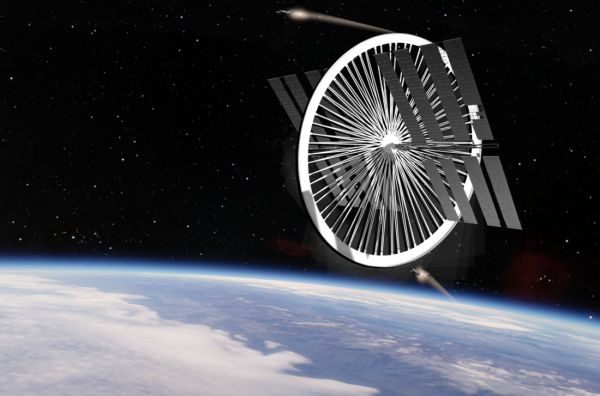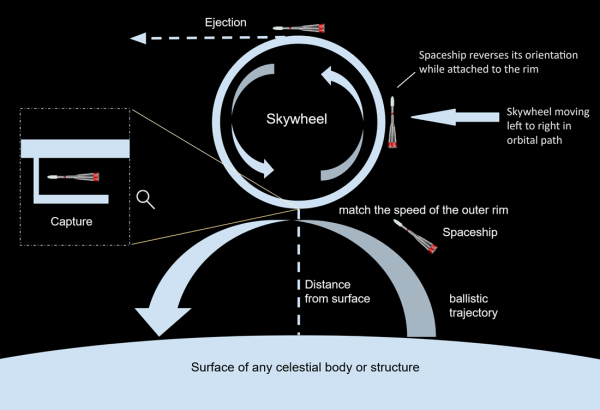BY LETTER
Skywheel
 Image from Steve Bowers |
For ascending to orbit, a spacecraft attaches to the bottom portion of a skywheel's rim, remains there until it reaches the highest point, and then detaches to be thrown into orbit. This can also be done in reverse (attaching to the top and detaching from the bottom) for a spacecraft to shed its velocity for docking with a habitat or hab cluster or landing on the surface of a world. Lifting a spacecraft into orbit reduces a skywheel's orbital velocity slightly, while landing a spacecraft does the opposite. Finally, a skywheel can also be used by a moving spacecraft to change its direction without altering its speed
In practice, skywheels also include multiple spokes leading to a central hub, which in turn has photovoltaic arrays, communication equipment and other attachments. The spokes are made of conductive materials, allowing the skywheel to control its orbital velocity using electrodynamic propulsion, provided it orbits a world with a magnetic field. If there is no magnetic field, then ion thrusters are used instead.
 Image from Avengium and Steve Bowers |
Despite their many advantages, skywheels do suffer from one major disadvantage: They require more material to build than a comparable rotovator. Specifically, it requires 2π (or about 6.28) times more material.
Because of this, skywheels are not normally used around newly settled worlds or in lightly settled systems, which prefer smaller infrastructure such as rotovators or the still-smaller bolos. Only after a world or system is developed and its orbital traffic becomes sufficiently busy are skywheels implemented. Materials used to construct skywheels can be launched into orbit via the same rotovators or bolos that they are to replace. Skywheels may in turn be replaced by beanstalks or orbital rings, which allow efficient transport directly to and from a planetary surface, or a civilization may opt to skip skywheels and progress directly to beanstalks/ orbital rings.
A few MPA systems continue using skywheels on a long-term basis, amused by the whimsy of gigantic wheels transporting objects through space.
Related Articles
- Lofstrom Loop
- Lorrey Loop - Text by Steve Bowers
Advanced form of Lofstrom Loop using three geostationary terminii in orbit at the points of an equilateral triangle, and three ground terminii opposite them, connected by a stream of vessels or particles which travel in Hofmann orbits (except when in the atmosphere), thereby saving energy. - Rotating Space Habitats
- Space Runways
- Vertical Skyhooks and Static Orbital Rings
Appears in Topics
Development Notes
Text by Tardigrada
Initially published on 21 December 2023.
Concept of the sky wheel based on the report Capture-ejector Satellites - Macconochie, Eldred and Martin (1983)
Initially published on 21 December 2023.
Concept of the sky wheel based on the report Capture-ejector Satellites - Macconochie, Eldred and Martin (1983)






